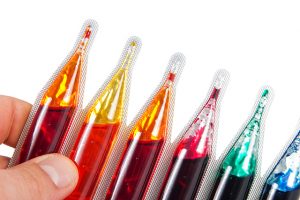
Indigo Carmine sources, health risks
Tuesday, October 24, 2017 by Michelle Simmons
http://www.naturalpedia.com/indigo-carmine-sources-health-risks.html

Indigo carmine is also known as indigotine, FD&C Blue 2, and E132. It is a blue artificial coal tar dye that is normally produced by a synthesis of indoxyl by fusion of sodium phenylglycinate in a mixture of caustic soda and sodamide. It is a deep blue dye that gives a violet to blue shade in applications. Indigotine or indigo carmine is a petroleum product with the chemical formula C16H10N2O2.
It was introduced following the discovery of the chemical structure of indigo by the Prussian research chemist J F W Adolf von Baeyer in the 1883 and it was used in the early 1900s, making it one of the oldest certified food color additives used in the United States.
It may be used as a food colorant in baked goods, ice cream, confections, cherries, sausage, sherbet, dairy products, dessert powders, cereals, snack foods, convenient foods, and pharmaceuticals. It also has non-food uses. It is used as a pH indicator, wherein it is blue at pH 11.4 and yellow at 13.0. moreover, it is used in obstetrics to help spot amniotic fluid leaks. Lastly, it is used during surgery to highlight the urinary tract and help to detect leaks.
It is approved for usage in several countries such as the U.S., Canada, India and EU. On the other hand, it is banned in Norway.
Harmful effects that can be caused by indigo carmine
Since it is synthetic, it is made from dangerous chemicals. There are several harmful effects that indigo carmine can cause. One of these is hyperactivity. A study in 2007 found an association between artificial colorings, which include indigo carmine, and hyperactivity. It was revealed that drinking the beverage with artificial colors and a preservative resulted to an increased hyperactivity in the children.
Another study on laboratory rats found that a high dosage of indigo carmine greatly increased the brain cancer and other abnormal cell development. However, there are no studies on its carcinogenicity in humans.
Body systems harmed by indigo carmine
There are a few body systems harmed by indigo carmine and almost all of these are caused by contact with the chemical. This chemical can cause harm to the skin. It can cause skin irritation when in contact. It is best avoided by people with allergic reactions as it may cause skin sensitivity, a skin rash like nettle rash, itching, high blood pressure, and breathing problems. Particles of indigo carmine that come in contact in the eyes may irritate the eyes. If inhaled, it can be toxic and may cause irritation in the respiratory tract.
Where to learn more
- Candy bars recalled after tests reveal lead contamination
- The Food We Eat could have Poison in It
- Your Daily Additives – Dye Week – Aluminum Lake
- Know what you eat before you eat it
- Call for Ban on Eight Dangerous Food Dyes in U.S. Foods
Summary
Indigo carmine, also known as indigotine or FD&C Blue 2, is an artificial blue dye that can cause hyperactivity, irritations in the skin, eyes, and respiratory tract.
Sources include:
Tagged Under: Tags: indigo carmine






